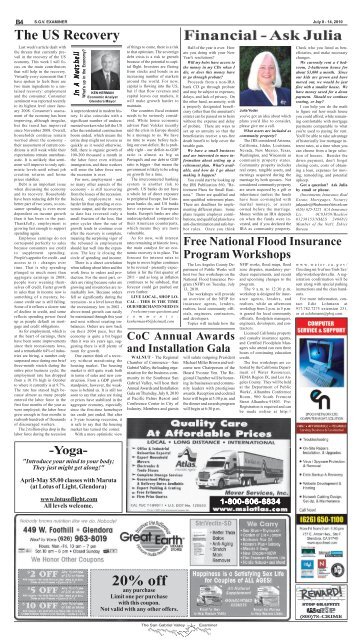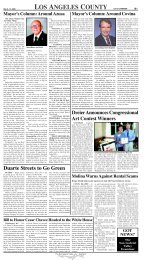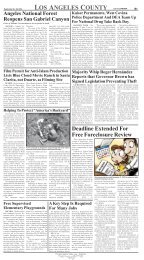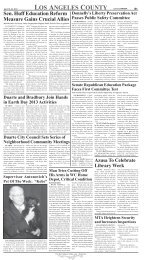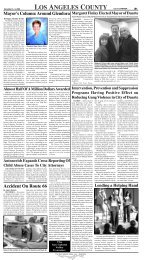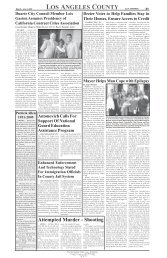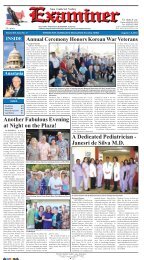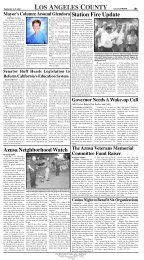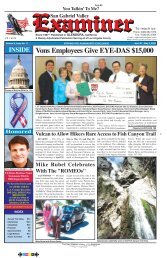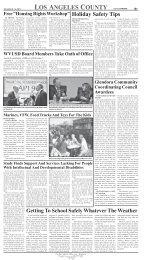B July 8 - 14 10.pmd - San Gabriel Valley Examiner
B July 8 - 14 10.pmd - San Gabriel Valley Examiner
B July 8 - 14 10.pmd - San Gabriel Valley Examiner
Create successful ePaper yourself
Turn your PDF publications into a flip-book with our unique Google optimized e-Paper software.
B4<br />
S.G.V. EXAMINER<br />
The US Recovery<br />
Last week's article dealt with<br />
the threats that currently prevail<br />
in the recovery of the US<br />
economy. This week I will focus<br />
on the main contributors<br />
that will help in the recovery.<br />
Virtually every economist that I<br />
have spoken to feels there are<br />
two main ingredients to a sustained<br />
recovery: employment<br />
and the consumer. Consumer<br />
sentiment was reported recently<br />
to its highest level since January<br />
2008. Consumer's assessment<br />
of the economy has been<br />
improving, although irregular,<br />
but the trend has improved<br />
since November 2008. Overall,<br />
households continue remain<br />
worried about the economy -<br />
their assessment of current conditions<br />
is still weak while their<br />
expectations remain unenthusiastic.<br />
It is unlikely that sentiment<br />
will improve to truly optimistic<br />
levels until robust job<br />
creation returns and home<br />
prices stabilize.<br />
Debt is an important issue<br />
when discussing the economy<br />
and its recovery. Households<br />
have been reducing debt for the<br />
better part of two years, so consumer<br />
spending is even more<br />
dependent on income growth<br />
than it has been in the past.<br />
Thankfully, employment is<br />
growing fast enough to support<br />
spending again.<br />
Employee earnings do not<br />
correspond perfectly to sales<br />
because consumers use credit<br />
to supplement spending.<br />
People's appetite for credit - and<br />
access to it - changes over<br />
time. That is why spending<br />
plunged so much more than<br />
aggregate earnings in 2008;<br />
people were weaning themselves<br />
off credit. Faster growth<br />
in sales than in income now is<br />
something of a mystery, because<br />
credit use is still falling.<br />
Some of it reflects a slower rate<br />
of decline in credit, and some<br />
reflects spending power freed<br />
up as people default on mortgage<br />
and credit obligations.<br />
As for employment, which is<br />
at the heart of earnings, there<br />
have been some improvements<br />
since their recessionary lows,<br />
and a remarkable 64% of industries<br />
are hiring, a number only<br />
surpassed once during one brief<br />
three-month stretch during the<br />
entire prior business cycle; the<br />
employment rate has dropped<br />
from a 10.1% high in October<br />
to where it currently is at 9.7%.<br />
The rate has stayed high because<br />
almost as many people<br />
entered the labor force in the<br />
first four months of the year as<br />
were employed; the labor force<br />
grew enough in four months to<br />
reabsorb hundreds of thousands<br />
of discouraged workers.<br />
The 2 million-plus drop in the<br />
labor force during the recession<br />
In In A A Nutshell<br />
Nutshell<br />
What’s up in the Economy?<br />
KEN HERMAN<br />
Economic Analyst<br />
Glendora Mayor<br />
is unprecedented in modern history.<br />
It also coincides with a<br />
significant number of undocumented<br />
workers who left the US<br />
after the residential construction<br />
boom ended, which means the<br />
entire drop might not reverse as<br />
quickly as it would otherwise.<br />
Still, there is organic growth of<br />
100-200 thousand a month in<br />
the labor force even without<br />
immigration, and these workers<br />
will enter the labor force now<br />
the recession is over.<br />
For now, employment - and<br />
so many other aspects of the<br />
economy - is still recovering<br />
from the losses of the recession.<br />
Indeed, employment was<br />
harder hit than spending or economic<br />
output, and the recovery<br />
to date has reversed only a<br />
small fraction of the loss. But<br />
prior cycles show the rate of<br />
growth tends to continue even<br />
after the recovery is complete,<br />
meaning the surprising vigor of<br />
the rebound in employment<br />
should last well into the expansion.<br />
The key is closing the<br />
circle of spending and income.<br />
There is a direct correlation<br />
when talking about labor and the<br />
work force to orders and production.<br />
For the most part, orders<br />
are rising because sales are<br />
growing and inventories are remarkably<br />
low. Because orders<br />
fell so significantly during the<br />
recession - to a level lower than<br />
the recessionary low in 2002 -<br />
above-trend growth can easily<br />
be maintained through this year<br />
and next without creating imbalances.<br />
Orders are now back<br />
on their 2004 pace, but the<br />
economy is quite a bit bigger<br />
than it was six years ago, suggesting<br />
there is still plenty of<br />
room for growth.<br />
One cannot think of a recovery<br />
without mentioning the<br />
housing market. The housing<br />
market is still quite weak both<br />
in terms of sales and new construction.<br />
From a GDP growth<br />
standpoint, however, the weakness<br />
is behind us. It is still too<br />
soon to say that sales are rising<br />
or prices have stabilized in the<br />
aggregate economy, especially<br />
since the first-time homebuyer<br />
tax credit just ended. But after<br />
a 5-year housing recession, it<br />
is safe to say that the housing<br />
market has turned the corner.<br />
With a more optimistic view<br />
-Yoga-<br />
"Introduce your mind to your body;<br />
They just might get along!"<br />
April-May $5.00 classes with Maruta<br />
(at Lotus of Light, Glendora)<br />
www.lotusoflight.com<br />
All levels welcome.<br />
of things to come, there is a risk<br />
to that optimism. The sovereign<br />
debt crisis is a risk to growth<br />
because of the potential to capital<br />
flight. Investors are fleeing<br />
from stocks and bonds in an<br />
increasing number of markets<br />
around the world. For now,<br />
capital is flowing into the US,<br />
but if that flow reverses and<br />
capital leaves our markets, it<br />
will make growth harder to<br />
maintain.<br />
Our countries fiscal restraint<br />
needs to be seriously considered.<br />
White house economic<br />
advisor Paul Volcker recently<br />
said the crisis in Europe should<br />
be a message to us. We have<br />
no time to waste before tackling<br />
our own deficit. He is probably<br />
right - our deficit-to-GDP<br />
ratio is almost as big as<br />
Portugal's and our debt to GDP<br />
ratio is bigger - that means the<br />
government is likely to be a drag<br />
on growth for a time.<br />
The interconnected banking<br />
system is another risk to<br />
growth. US banks do not have<br />
a whole lot of direct exposure<br />
to peripheral Europe, but European<br />
banks do, and US banks<br />
have exposure to European<br />
banks. Europe's banks are also<br />
undercapitalized compared to<br />
their American counterparts,<br />
which means they are more<br />
vulnerable.<br />
As for now, with interest<br />
rates remaining at historic lows,<br />
the main catalyst for an economic<br />
recovery is in place. The<br />
forecast for interest rates to<br />
begin to move higher continues<br />
to be revised - presently expectation<br />
is for the first quarter of<br />
2011 - and as long as inflation<br />
continues to be subdued, that<br />
forecast could get pushed out<br />
even further.<br />
LIVE LOCAL, SHOP LO-<br />
CAL - THIS IS THE TIME<br />
OUR MERCHANTS NEED US<br />
I welcome your questions and<br />
c o m m e n t s :<br />
kenherman46@hotmail.com<br />
20% off<br />
any purchase<br />
Limit one per purchase<br />
with this coupon.<br />
Not valid with any other offers.<br />
Half of the year is over. How<br />
are you doing with your New<br />
Year's resolutions?<br />
Will my heirs have access to<br />
the money in my CDs when I<br />
die, or does this money have<br />
to go through probate?<br />
Proceeds from a non-IRA<br />
bank CD go through probate<br />
and may be subject to expenses,<br />
delays, and lack of privacy. On<br />
the other hand, an annuity, with<br />
a properly designated beneficiary<br />
(other than the annuitant's<br />
estate) can be passed on to heirs<br />
without the expense and delay<br />
of probate. There are ways to<br />
set up an annuity so that the<br />
beneficiaries receive a tax-free<br />
death benefit to help cover the<br />
taxable gain.<br />
We have a small business<br />
and are interested in more information<br />
about setting up a<br />
retirement plan. What's available,<br />
and how do I go about<br />
making it happen?<br />
You could start by looking up<br />
the IRS Publication 560, "Retirement<br />
Plans for Small Business."<br />
There are qualified and<br />
non-qualified retirement plans.<br />
There are deadlines for implementing<br />
different plans. Some<br />
plans require employer contributions,<br />
and qualified plans have<br />
anti-discrimination and safe-harbor<br />
rules. Once you think<br />
The Los Angeles County Department<br />
of Public Works will<br />
host two free workshops on the<br />
National Flood Insurance Program<br />
(NFIP) on Tuesday, <strong>July</strong><br />
13, 2010.<br />
The workshops will provide<br />
an overview of the NFIP for<br />
insurance agents, lenders,<br />
realtors, local community officials,<br />
engineers, contractors,<br />
and developers.<br />
Topics will include how the<br />
CoC Annual Awards<br />
and Installation Gala<br />
WALNUT - The Regional<br />
Chamber of Commerce—<strong>San</strong><br />
<strong>Gabriel</strong> <strong>Valley</strong>, the leading organization<br />
for the business community<br />
in the Southeast <strong>San</strong><br />
<strong>Gabriel</strong> <strong>Valley</strong>, will host their<br />
Annual Awards and Installation<br />
Gala on Thursday, <strong>July</strong> 8, 2010<br />
at Pacific Palms Resort and<br />
Conference Center in City of<br />
Industry. Members and guests<br />
The <strong>San</strong> <strong>Gabriel</strong> <strong>Valley</strong> <strong>Examiner</strong><br />
Julia Yoder<br />
you've got an idea about which<br />
plans you'd like to consider,<br />
please give me a call.<br />
What assets are included as<br />
community property?<br />
The IRS considered Arizona,<br />
California, Idaho, Louisiana,<br />
Nevada, New Mexico, Texas,<br />
Washington, and Wisconsin as<br />
community property states.<br />
Community property includes<br />
real estate, tangible assets, and<br />
earnings acquired during the<br />
marriage by both spouses. Not<br />
considered community property<br />
are assets acquired by a gift or<br />
inheritance (unless the funds<br />
have been co-mingled with<br />
marital money), or assets<br />
owned before the marriage.<br />
Money within an IRA depends<br />
on when the funds were invested,<br />
and if you declared the<br />
IRA as community property.<br />
1-800-606-6834<br />
1-800-606-6834<br />
<strong>July</strong> 8 - <strong>14</strong>, 2010<br />
Check who you listed as beneficiaries,<br />
and make necessary<br />
changes.<br />
We currently rent a 4 bedroom,<br />
2-bathroom house for<br />
about $3,000 a month. Since<br />
our kids are grown and have<br />
moved out, we would be just<br />
fine with a smaller house. We<br />
have money saved for a down<br />
payment. Should we continue<br />
renting, or buy?<br />
I can help you do the math<br />
to figure out how much house<br />
you could afford, while remaining<br />
comfortable with mortgage<br />
payments comparable to what<br />
you're used to paying for rent.<br />
You'll be able to take advantage<br />
of historically low mortgage interest<br />
rates, at a time when you<br />
can choose from a large selection<br />
of houses. Besides the<br />
down payment, don't forget<br />
closing costs, costs of obtaining<br />
a loan, expenses for moving,<br />
remodeling, and potential<br />
upkeep.<br />
Got a question? Ask Julia<br />
by email or phone.<br />
(Investments, Insurance, Real<br />
Estate, Mortgages, Notary)<br />
juliayoder@WiseInvestorsNetwork.com<br />
(626) 625-5221 (CA Insurance<br />
Lic. 0C83859/Realtor<br />
01238153/NMLS 248681)<br />
Member of the Nat'l. Ethics<br />
Bureau<br />
Free National Flood Insurance<br />
Program Workshops<br />
will salute outgoing President<br />
Michael Miller Brown and welcome<br />
new Chairperson of the<br />
Board Yvonne Yen. The Regional<br />
Chamber will be honoring<br />
its businesses and community<br />
leaders with prestigious<br />
awards. Reception and cocktail<br />
hour will begin at 5:30 p.m. and<br />
the dinner and awards program<br />
will begin at 6:30 p.m.<br />
NFIP works, flood maps, flood<br />
zone disputes, mandatory purchase<br />
requirements, and recent<br />
and upcoming changes to the<br />
program.<br />
The 9 a.m. to 12:30 p.m.<br />
workshop is designed for insurance<br />
agents, lenders, and<br />
realtors, while an afternoon<br />
workshop from 2 p.m. to 5 p.m.<br />
is geared for local community<br />
officials, floodplain managers,<br />
engineers, developers, and contractors.<br />
Licensed California property<br />
and casualty insurance agents,<br />
and Certified Floodplain Managers<br />
who attend can earn three<br />
hours of continuing education<br />
credit.<br />
The free workshops are cohosted<br />
by the California Department<br />
of Water Resources,<br />
FEMA Region IX, and Los Angeles<br />
County. They will be held<br />
at the Department of Public<br />
Works', Alhambra Conference<br />
Room, 900 South Fremont<br />
Street Alhambra 91803. Pre-<br />
Registration is required and can<br />
be made online at http://<br />
www.water.ca.gov/<br />
floodmgmt/lrafmo/fmb/fas/<br />
nfip/workshop/dwr.cfm. A registration<br />
confirmation will be<br />
sent along with special parking<br />
instructions and the class handouts.<br />
For more information, contact<br />
Edie Lohmann at<br />
917.782.7275 extension 231,<br />
or at eclohmann@pbsj.com.


